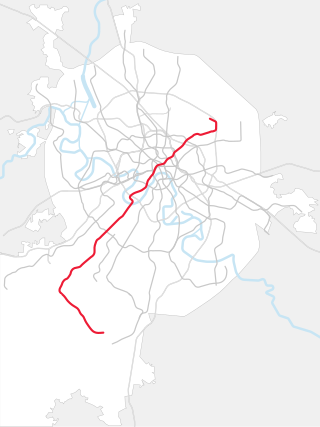
Nevsky Prospect is a main street located in the federal city of St. Petersburg in Russia. Its name comes from the Alexander Nevsky Lavra, the monastery which stands at the eastern end of the street, and which commemorates the Russian hero Prince Saint Alexander Nevsky (1221–1263). Following his founding of Saint Petersburg in 1703, Tsar Peter I planned the course of the street as the beginning of the road to Novgorod and Moscow. The avenue runs from the Admiralty in the west to the Moscow Railway Station and, after veering slightly southwards at Vosstaniya Square, to the Alexander Nevsky Lavra.

The Sokolnicheskaya line (Russian: Соко́льническая ли́ния, IPA:[sɐˈkolʲnʲitɕɪskəjəˈlʲinʲɪjə], formerly Kirovsko-Frunzenskaya is a line of the Moscow Metro. It opened in 1935 and is the oldest in the system. There are currently 26 stations open on the line. As of 2019, the line is 44.5 kilometres long.

The Zamoskvoretskaya line, formerly Gorkovsko–Zamoskvoretskaya (Го́рьковско-Замоскворе́цкая), is a line of the Moscow Metro. Opened in 1938, chronologically it became the third line. There are 24 stations on the Zamoskvoretskaya line, and it spans 42.8 kilometres (26.6 mi), roughly crossing Moscow in a north–south direction. A normal trip along the entire line takes 55 minutes, with the trains on the line averaging 42 kilometres per hour (26 mph). While most of the line is underground, there are some pockets of surface-level or above-ground track, mainly at the point where the line crosses the Moskva River. The line contains many examples of original Moscow Metro architecture, and contains arguably the most photographed station on the entire network: Mayakovskaya.

Komsomolskaya is a Moscow Metro station in the Krasnoselsky District, Central Administrative Okrug, Moscow. It is on the Sokolnicheskaya line, between Krasnye Vorota and Krasnoselskaya stations. It is located under Komsomolskaya Square, between the Leningradsky, Yaroslavsky, and Kazansky railway terminals. The station was named for the workers of the Komsomol youth league who helped to construct the first Metro line. It has a transfer at its namesake on the Koltsevaya line.

Park Kultury is a Moscow Metro station in the Khamovniki District, Central Administrative Okrug, Moscow. It is on the Sokolnicheskaya line, between Frunzenskaya and Kropotkinskaya stations. Named after the nearby Maxim Gorky Park of Culture and Leisure located across the Moskva River.

Kitay-gorod, also referred to as the Great Possad in the 16th and 17th centuries, is a cultural and historical area within the central part of Moscow in Russia, defined by the remnants of now almost entirely razed fortifications, narrow streets and very densely built cityscape. It is separated from the Kremlin by the Red Square. Kitay-gorod does not constitute a district (raion), as there are no resident voters, thus, municipal elections are not possible. Rather, the territory has been part of Tverskoy District, and the Central Administrative Okrug authorities have managed the area directly since 2003.

Tverskaya Street, known between 1935 and 1990 as Gorky Street, is the main radial street in Moscow. The street runs Northwest from the central Manege Square in the direction of Saint Petersburg and terminates at the Garden Ring, giving the name to Tverskoy District. The route continues further as First Tverskaya-Yamskaya Street, Leningradsky Avenue and Leningradskoye Highway.

Moscow Leningradsky railway terminal also known as Moscow Passazhirskaya station is the oldest of Moscow's nine railway terminals. Situated on Komsomolskaya Square, the station serves north-western directions, notably Saint Petersburg. International services from the station include Tallinn, Estonia, operated by GoRail, and Helsinki, Finland.

Komsomolskaya Square, known as Kalanchyovskaya before 1932, is a square in Moscow, with a blend of revivalist Tsarist and Stalinist architecture. It is referred to informally as Three Station Square after the three rail termini situated there: Leningradsky, Yaroslavsky, and Kazansky. These stations connect Moscow with Saint Petersburg, northwestern Russia, the Volga region, and Siberia via the Trans-Siberian Railway.

Leningradsky Prospekt, or Leningrad Avenue, is a major arterial avenue in Moscow, Russia. It continues the path of Tverskaya Street and 1st Tverskaya-Yamskaya Street north-west from Belorussky Rail Terminal, and changes the name once again to Leningradskoye Highway past the Sokol metro station. The Highway continues its way to Saint Petersburg via Tver.

Kazansky railway terminal also known as Moscow Kazansky railway station is one of nine railway terminals in Moscow, situated on the Komsomolskaya Square, across the square from the Leningradsky and Yaroslavsky stations. It was ranked nr. 9 in a list of Europe’s best train stations by the Consumer Choice Centre in 2020.

Dorogomilovo District is a district of Western Administrative Okrug of the federal city of Moscow, Russia. The area of the district is 7.93 square kilometres (3.06 sq mi). Population: 67,720 (2010 Census); 59,732 (2002 Census). Postal codes: 113000 to 119000.

The Fountains in Moscow once provided drinking water to Muscovites, and now decorate many of the city's squares and parks. Only one fountain built before the 1917 Revolution, the Petrovskiy Fountain in front of the Bolshoi Theater, still remains on its original site. Few fountains were built in Soviet times, but many new fountains were built in the 1990s and first decade of the 21st century during the city's post-Soviet economic boom. Because of the cold climate, the fountains only operate in the warm season, usually from May 1 until October 1.

Saint Petersburg – second-largest city in Russia. An important Russian port on the Baltic Sea, it has the status of a federal subject. Its name was changed to "Petrograd" in 1914, then to "Leningrad" in 1924, and back to Saint Petersburg in 1991.

Moscow City Day is a city-wide holiday held in Moscow. It is celebrated on the first or second Saturday of September. The celebration involves free cultural events, a parade and evening fireworks. The first city day was held in 1847 to celebrate Moscow's 700th anniversary.





























